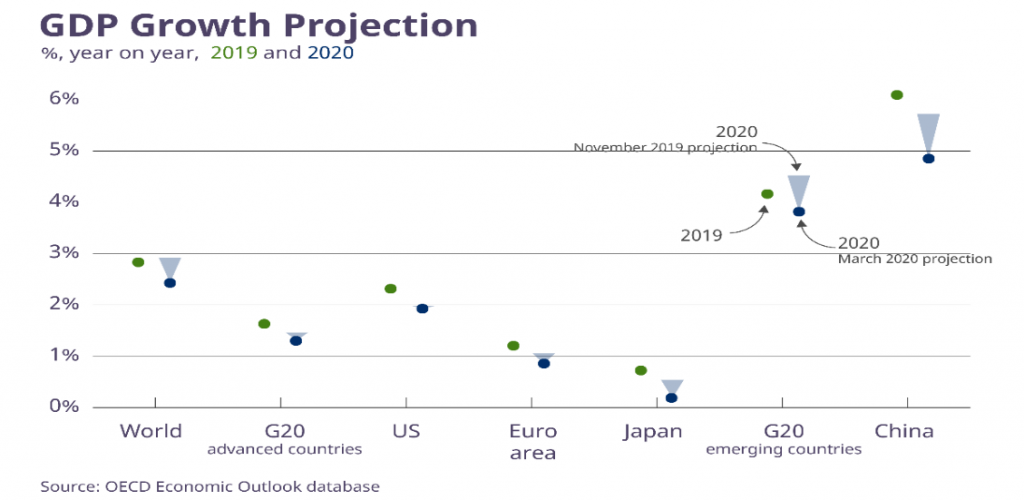Oil Market Price War– Australian and Canadian Dollar

Nikolas
Stylianou
16 March 2020
Oil
Market Price War– Australian and Canadian Dollar
Oil price last
week reached its slowest level since the Gulf war of 1991 at almost 27 dollar
per barrel. Oil demand decreased dramatically in short term taking into
consideration that, since the coronavirus outbreak, the oil lost around 30
dollars on its value. Russia resisted and refused to follow O.P.E.C instruction
to cut oil production by 500,000 barrels less per day. Russia is trying to
fight US shale producers and US fracking companies by increasing even more its
oil production rather than cutting it, due to the competition they have with US
in oil supply. By this way they will create a lot of debt to the fracking
companies and will take a toll on US oil exports by increasing their oil
production and at the same time lowering the oil price. Saudi Arabia also
commenced increasing its oil production as Russia did, and both of them have a
lot of billions of oil reserves that can be used later to cover all losing
revenues from now. In the meantime, as per analysts, the oil price it’s
expected to reach 20 dollars per barrel the next couple of days and US shell
companies will be forced to cut production which might generate threats for
bankruptcy. Current oil price is at 26 per barrel. The Australian and Canadian
dollar were impossible to remain unaffected from the Oil trade war. The pairs
depreciated against dollar and closed the week by almost 3%. AUS200 stock index
fell by 3% last week. Both countries Central Banks followed the Fed, proceeded
in cutting their rates by 0.5%. On Thursday, the Bank of Canada said it would
provide billions of dollars of more liquidity and Canadian government bond
yields rose across a steeper yield curve. The Bank of Canada has made an
unexpected rate cut, cutting the central bank’s benchmark interest rate by 50
basis points to 0.75 per cent by the end of the week. It’s expected to see
Aussie dollar recovering amid expectations that the unemployment will decreases
for the last two months.
Foreign
Exchange Currencies – European Stocks – ECB decisions
Last three
week’s euro performance against dollar showed how America stocks market was
affected from the coronavirus. Euro has recovered to approximately 6000 points
in a timeframe of 2 weeks, however last week euro price plunged after the
European Central Bank interest rate decision and measures taken to confront the
coronavirus spread. On Thursday Christine Lagarde announced that the interest
rate will remain unchanged to minus 0.5%, despite market expectation of further
rate cut. The interest rate is already negative, and this was the reason that
ECB did not lower even more the rate as they believe that more rate cut will
not be strong solution. The negative rate is meant to spur banks to loan money
rather than park it at the central bank. As per ECB, the interest rate on the
main refinancing operations and the interest rates on the marginal lending
facility and the deposit facility will remain unchanged at 0.00%, 0.25% and
-0.50% respectively. Another measure that has been taken is that ECB expanded
its asset purchase program by 120 billion by buying corporate bonds to help
businesses. All European stock market fall last week by almost 10%. European
index STOXX600 last week declined by 7%, DAX30, Italy, France and Spain indexes
declined to approximately 9%. According to City A.M. Media Group Italian and
Spanish securities regulators have implemented a ban on the short selling of
more than 100 stocks following record losses. According to FxEmpire, the losses
were also driven in part by a new declaration by the World Health Organization
that coronavirus had reached pandemic levels. The Reserve Bank of New Zealand
cuts key interest rate to 0.25% from 1%. Government plans broad-based economic
stimulus. Negative economic implications of the coronavirus continue to rise,
warranting further monetary stimulus.
US
Stock Markets – Gold and Treasuries Yields
Measures called
circuit breakers approved last week by the Securities and Exchange Commission
(SEC) to curb panic-selling on U.S. stock exchanges. They apply both to broad
market indices such as the S&P 500 and Dow Jones Industrial Index as well
as to individual securities. Circuit breakers function by temporarily halting
trading when prices hit predefined levels, such as a 13% intraday drop for the
stock market. Dow jones dropped by 10%
facing its worst week amid coronavirus threats, and from the fact that Donald
Trump announced the suspension travelling from Europe to US by the following 30
days as a measure to confront the virus. The drop on Dow Jones derived also
from the Boeing manufacturing company of airplanes, which lost almost 13
billion dollars and afterward Trump declared a national emergency. Another
reason that led DJ30 to fall is that the Democrats do not support the payroll
tax cut initially proposed by Donald Trump aiding to confront the virus. CME
Group announced on Wednesday night that it will close its Chicago trading floor
as precaution measure due to coronavirus. Predictions show that we expect
further decline to US market stock, and that indicates that gold price might
continue falling lower due to high risk aversion. This uncertainty lead
investors to sell the precious metals in order to cover their losses from the
stock market. Gold closed by almost 10% lower by the last week and is traded on
1520 dollar per ounce. It’s expected to find lower levels at 1450 per ounce.
Investors expecting further rate cut from the Federal Reserve Bank on Wednesday
March 18 to stimulate the economy. Fed also pumped the market with 1.5 trillion
in order to boost the economy and announce that will purchase around 37 billion
dollars for treasuries in order to help business to borrow money. Meanwhile,
the US Federal Reserve overnight injected US$500 billion into the US banking
system and pledged to add another US$1 trillion. It’s expected to see whether
Fed cut even more the rate, and in that case, gold might go to higher levels as
this indicates buy opportunities for gold investors amid US market short
recovering. Another reason that gold prices went even lower is because bonds
yield. which are the coupons or interest rates of bond rose as bonds prices
falling as stock market falling and investors trying to sell bond and gold
which are save heaven assets. The 10-year Treasury note yield TMUBMUSD10Y,
0.981% was up 10.4 basis points to 0.946%, adding to a weeklong rise of 23.7
basis points, the largest such increase since last September.
Bank
of England Rate decision
Following the
Fed, Bank of England proceeded to cut the base rate from 0.75% to 0.25% in an
emergency response to the “economic shock” of the coronavirus
outbreak. As per MSE news, BoE responses to help and support business and
consumer confidence at a difficult time, to bolster the cash flows of
businesses and households, to reduce the cost and to improve the availability
of finance. Pound/dollar last week fall by almost 3% and pound against euro fell
by 4%. In addition, pound fell after the announcement the UK infections reached
almost 1400.
Asian
Markets
India,
Singapore, Australia, Japan, Thailand, Indonesia and the Philippines are also
in bear markets. Benchmarks in Japan, Thailand and India sank as much as 10%
following Wall Street’s biggest drop since the Black Monday crash of 1987. China
cut the reserve requirement ratio for some banks by 0.5 to 1 percentage point,
effective from 16 March unleashing US$78 billion of liquidity to support the
world’s second largest economy from a deeper slowdown. The Shanghai Composite Index
closed with a weekly loss of 4.9%, Asia-Pacific markets, Tokyo’s Nikkei 225
declined by 7% and Hong Kong Index declined by almost 4%. Safe heaven
instrument JPY weakened last week against euro and dollar. It’s expected to see
further interest rate cut, but it may be deferred to April as there is already
a deeper required rate of return targeted cut in March and predictions shows
that this cut will make the yuan weaker against the dollar and is believed
USD/CNY and USD/CNH could cross 7.0 soon. Although that Asian stocks falling, losses
and infections narrowed in mainland China, where communities are recovering
from the worst of the virus.
Expectations
and Forecast in Asia, US and Europe according to Nomura:
- A new economic-growth estimate
from JPMorgan projects that a recession will hit the US and European economies
by July. - JPMorgan economists now expect
US GDP to shrink by 2% in the first quarter and 3% in the second and Eurozone GDP
could contract by 1.8% and 3.3% over the same periods, the economists said. - It’s expected the Bank of Japan
to decide expansion of ETF purchase in the March Monetary Policy Meeting - The risk is renewed yen
appreciation, caused by concerns over global recession and further rate cuts by
overseas central banks - Lower oil prices are unlikely
to benefit Asia’s growth in the short-term, but they should add to
disinflationary pressures. - Responding to rising risks and
tighter financial conditions, we expect a 100bp cut from the FOMC in March,
reaching the ELB

